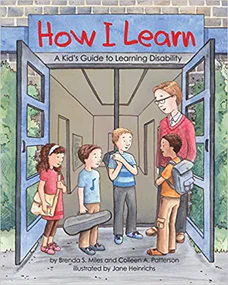How I Learn
A Kid’s Guide to Learning Disability

Recommended Age Range: 1st grade through 3rd grade.
Publisher's Summary:
Once a child is diagnosed with a learning disability, another journey begins. How do you explain learning problems to a child? What strategies may support academic success? How I Learn provides a simple explanation of why some children struggle. It introduces learning disability in concrete terms for younger students, emphasizing that they are capable of learning, but they do so in a different way.

Dr. Annie's Takeaways
Recommended for: This book features three children with learning disabilities in reading, writing, and math. It explains the concept of a learning disability and instills hope that with the right accommodations and lots of practice, a child “can do anything.” This book is a good read for a child who has recently been diagnosed with a learning disability and who will benefit from normalization and hope that accommodations will help them to learn.
Evidence-Based Practices:
Psychoeducation
Tone: Matter-of-fact, reassuring
Story Quality: This book is written in clear, straight-forward, first person language. It is neither stigmatizing nor euphemistic, and it repeats the reframe, “and that’s okay” in order to drive home the message that disabilities and differences are really, truly, okay.
Illustrations: Soft, friendly illustrations in watercolor and ink.
Representation: The narrator is a White boy with a White mom and dad. He has trouble reading, but the word “dyslexia” is not specifically used. He identifies as having a “learning disability.” Two other kids are featured in the book: Carmen, who has difficulty writing, and Henry who has difficulty with math. Carmen is White or Latina and has a mom and a dad (both with light colored skin brown hair) and a baby sibling. Henry is Black and has a Black father. The kids’ teacher is a Black man, and the narrator’s “extra help teacher” is an Asian woman (Ms. King).
Psychological Practices: This book starts out by introducing the idea that it’s okay to learn in a “different way.” It highlights its narrator’s strengths (“I am good at many things, like sports, helping my teacher, and playing board games. I am r-e-a-l-l-y good at drawing! And I am GREAT at making friends!”) and then describes his challenges with reading, Carmen’s difficulties with writing, and Henry’s with math. The narrator states, “There’s a reason why some things are hard for me, Carmen, Henry, and for you, too. It’s called a learning disability, or LD for short." The book then describes accommodations that help the kids to learn. The narrator raises his hand for help, uses a computer that reads to him, works with a reading specialist, and reads books with his parents. Carmen makes a list of her ideas, and then puts her ideas into sentences. Her parents help her to write them down. Henry’s family helps “make math fun by counting and measuring in the kitchen,” and he uses a calculator at school. The book ends by reassuring kids that “when we do smart things to help us learn, we feel like we can do anything!”
Concerns: None.
